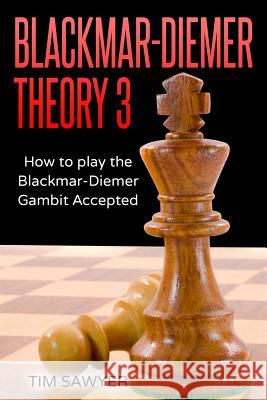Blackmar-Diemer Theory 3: How to Play the Blackmar-Diemer Gambit Accepted » książka
Blackmar-Diemer Theory 3: How to Play the Blackmar-Diemer Gambit Accepted
ISBN-13: 9781540532633 / Angielski / Miękka / 2016 / 122 str.
This Blackmar-Diemer Theory 3 book provides accurate chess analysis of the Gambit Accepted after 1.d4 d5 2.e4 dxe4 3.Nc3 Nf6 4.f3 exf3. Critical lines are shown as concisely as possible. This book has been arranged according to the 50 variations that you are most likely to see. All the chess analysis and evaluations in this book have been checked with computer chess engines. Is Blackmar-Diemer Gambit sound? That's a loaded question. Statistically White has scored 58% from the official 4.f3 BDG position. That compares favorably to 54% for all openings. On a practical level, it is sound. The author has won 2000 games with the Blackmar-Diemer Gambit. His performance rating after 4.f3 is 101 rating points higher when he plays the BDG. Your results may vary Playing a gambit is like being in a horse race. There is always a "rabbit" horse that starts quickly out front. That horse is passed by another moving faster once that winner gets up to speed. The player who accepts the gambit is out front at the first turn. The gambit player has a lead in development and open lines, so he is gaining quickly making threats as he assembles his army. How do you win from behind? You must go fast and hard. Does it work? Often it does. If not, this book can help you start better. The opening is important. If you begin well you can end well. But understand this. The start is just the beginning. What happens next? That is up to the players. The solution is at the finish line. The author Tim Sawyer is well known for chess opening books and his chess analysis. This chess repertoire on the Blackmar-Diemer is one of his favorite chess openings for White. This Blackmar-Diemer series of six chess books has skin, bones, and muscle. Books 1 and 2 verbally describe how the BDG looks and feels in hundreds of annotated games by players from all levels. Those are the outer skin level, what it feels like to play the BDG. Now to the skeleton on which the opening stands. The chess theory Books 3 and 4 cover the theory of BDG. This is book three. It is the bare bones analysis of chess opening theory with a lot of original analysis. There are no player stories, and no explanations about what is going on. What you have is 50 variations of the Blackmar-Diemer Gambit clearly outlined and divided so that you can find any line quickly. The muscle that follows is planned for Books 5 and 6. They show the power of the opening through master games but without any annotations. Some of those games did appear with annotations in my first two books. Many more are planned for Books 5 and 6. Now a word about transpositions. The BDG can be reached by many move orders. Here are the most common paths to 4.f3: 1.d4 d5 2.e4 dxe4 3.Nc3 Nf6 4.f3. 1.d4 d5 2.e4 dxe4 3.f3 Nf6 4.Nc3. 1.d4 Nf6 2.Nc3 d5 3.e4 dxe4 4.f3. 1.d4 Nf6 2.f3 d5 3.e4 dxe4 4.Nc3. 1.e4 d5 2.d4 dxe4 3.Nc3 Nf6 4.f3. 1.e4 Nf6 2.Nc3 d5 3.d4 dxe4 4.f3. Here are BDGs that do not pass through the same 4.f3 position: 1.e4 c6 2.d4 d5 3.Nc3 dxe4 4.f3 exf3 5.Nxf3 Nf6 (Ziegler). 1.e4 e6 2.d4 d5 3.Nc3 dxe4 4.f3 exf3 5.Nxf3 Nf6 (Euwe). 1.d4 d5 2.e4 dxe4 3.Nc3 Bf5 4.f3 exf3 5.Nf3 Nf6 (Gunderam) In my first Blackmar-Diemer Gambit Keybook I wrote this: "Blackmar-Diemer Gambit is not a boxing jab; it is a knockout punch. White gets to throw the first punch Stop playing for the endgame; start playing to end the game Be a winner. Play the Blackmar-Diemer Gambit " Theoretical analysis brings you into the middle of the boxing ring. Now you can knock out your opponent. The author places White in the best situation possible. Start throwing your punches. It's your move
Zawartość książki może nie spełniać oczekiwań – reklamacje nie obejmują treści, która mogła nie być redakcyjnie ani merytorycznie opracowana.











